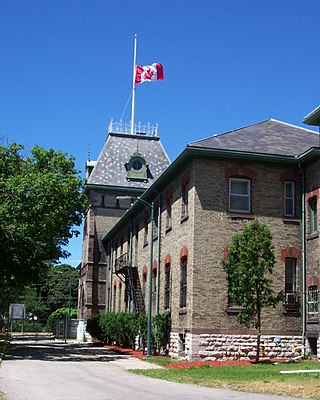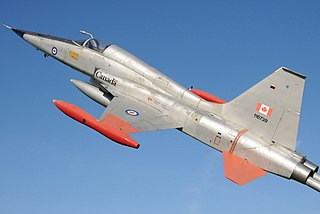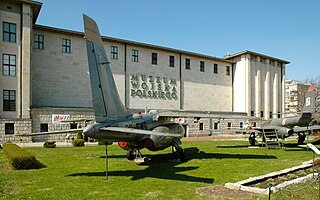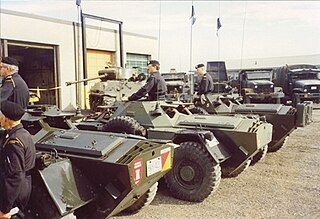
The 8.8 cm Flak 18/36/37/41 is a German 88 mm anti-aircraft and anti-tank artillery gun, developed in the 1930s. It was widely used by Germany throughout World War II and is one of the most recognized German weapons of the conflict. The gun was universally known as the Acht-acht ("eight-eight") by the Germans and the "eighty-eight" by the Allies. Due to its lethality, especially as a tank killer, the eighty-eight was greatly feared by Allied soldiers.

The Royal Regiment of Canadian Artillery is the artillery personnel branch of the Canadian Army.

The Oerlikon/Martin Marietta Air Defense Anti Tank System is a dual-purpose short range surface-to-air and anti-tank missile system based on the M113A2 vehicle. The ADATS missile is a laser-guided supersonic missile with a range of 10 kilometers, with an electro-optical sensor with TV and Forward Looking Infrared (FLIR). The carrying vehicle also has a search radar with an effective range of over 25 kilometers.
Canadian Forces Base Shilo is an operations and training base of the Canadian Armed Forces, located 35 km (22 mi) east of Brandon, Manitoba and adjacent to Sprucewoods. During the 1990s, Canadian Forces Base Shilo was also designated as an Area Support Unit, which acts as a local base of operations for south-west Manitoba in times of military and civil emergency.

Swords to ploughshares is a concept in which military weapons or technologies are converted for peaceful civilian applications.

The Royal Canadian Regiment Museum is located at Wolseley Barracks in London, Ontario, Canada.

The Marmon-Herrington Armoured Car was a series of armoured vehicles that were produced in South Africa and adopted by the British Army during the Second World War. RAF Armoured Car companies possessed them, but seem never to have used them in action, making greater use of Rolls-Royce Armoured Cars and other types.
Clive Michael Law (1954–2017) was a Canadian publisher and author, and founder and President of Service Publications. He wrote and edited several books dealing with the Canadian military, including ground-breaking works on Canadian distinguishing patches worn since 1916, as well as the uniforms of the Canadian Expeditionary Force, and was the Canadian subject matter expert on the Canadian Inglis High-Power Pistol. As a senior public servant for the Government of Canada, he worked with Global Affairs Canada, the Royal Canadian Mounted Police and Transport Canada.

The Dingo Scout Car was a light armoured car built in Australia during World War II. They were produced by the Ford motor company during 1942.

The Canadair CF-5 is a Canadian licensed-built Northrop F-5 Freedom Fighter, a light, supersonic, twin engine, daylight air superiority fighter primarily for the Canadian Forces and the Royal Netherlands Air Force. The CF-5 was upgraded periodically throughout its service career in Canada. The Canadian Forces retired the aircraft in 1995, although the CF-5 continues to be used by other countries.

Museum of the Polish Army is a museum in Warsaw documenting the military history of Poland. Established in 1920 under the Second Polish Republic, it occupies a wing of the building of the Polish National Museum as well as several branches in Poland. It is Warsaw's second largest museum and the largest collection of military objects in Poland. The collection illustrates a thousand years of Polish military history, from the 10th century to the Second World War.

The Oshawa Military and Industrial Museum, also known as The Ontario Regiment (RCAC) "Ferret Club," is an accredited Canadian Forces Museum located in Oshawa, Ontario, Canada. Founded in 1980, it has evolved into the Historic Vehicle Section of the Ontario Regiment Museum.
The Ontario Regiment (RCAC) Museum is a military museum located in Oshawa, Ontario, Canada. The museum is located on the South Field of the Oshawa Municipal Airport, 1000 Stevenson Rd N, Oshawa, Ontario.

An aviation museum, air museum, or air and space museum is a museum exhibiting the history and artifacts of aviation. In addition to actual, replica or accurate reproduction aircraft, exhibits can include photographs, maps, models, dioramas, clothing and equipment used by aviators.

The QF 1 pounder, universally known as the pom-pom due to the sound of its discharge, was a 37 mm British autocannon, the first of its type in the world. It was used by several countries initially as an infantry gun and later as a light anti-aircraft gun.

The South African National Museum of Military History in Johannesburg was officially opened by Prime Minister Jan Smuts on 29 August 1947 to preserve the history of South Africa's involvement in the Second World War. In 1975, the museum was renamed from the South African National War Museum and its function changed to include all conflicts that South Africa has been involved in. In 1999 it was amalgamated with the Pretoria-based Transvaal Museum and National Cultural History Museum to form the Northern Flagship Institution. In April 2010 Ditsong was officially renamed Ditsong Museums of South Africa and the SANMMH was renamed the Ditsong National Museum of Military History.

The Royal Military College of Canada Museum, established in 1962, is located in a Martello tower known as Fort Frederick on the campus of the Royal Military College of Canada in Kingston, Ontario, and is operated by the college. Until 2016 the museum had regular hours from the last weekend in June until Labour Day. Although admission was free, donations were accepted. Guided tours were offered in English and French. Genealogical research and archival records services were offered relating to college history or with inquires relating to ex-cadets when permitted by privacy regulations.

The Imperial Gift was the donation of aircraft from surplus stocks in Britain after World War I to the dominions of the British Empire: Canada, Australia, New Zealand, South Africa and India. On 29 May 1919, the Cabinet of the United Kingdom agreed to give 100 aircraft to the dominions in addition to replacements for aircraft donated to Britain during the war. These aircraft formed the core of newly established air forces in several dominions.
Colonel Michael David Calnan, CD was a Canadian Forces officer notable as a serving military member given permission to run for political office while still on active duty.
















